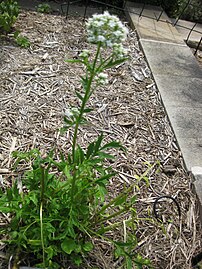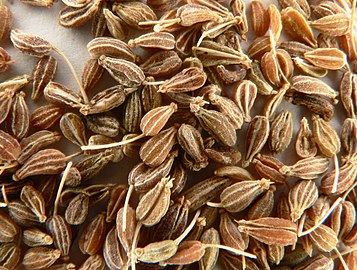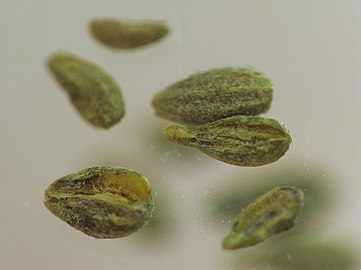Anise
| Anise | |
|---|---|
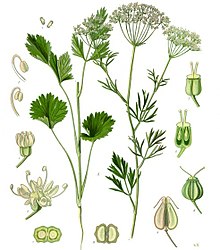
| |
| 1897 illustration[1] | |
| Scientific classification | |
| Kingdom: | Plantae |
| Clade: | Tracheophytes |
| Clade: | Angiosperms |
| Clade: | Eudicots |
| Clade: | Asterids |
| Order: | Apiales |
| Family: | Apiaceae |
| Genus: | Pimpinella |
| Species: | P. anisum
|
| Binomial name | |
| Pimpinella anisum | |
| Synonyms | |
|
Synonymy
| |
Anise (
The flavor and aroma of its seeds have similarities with some other spices and herbs, such as
Etymology
The name "anise" is derived via Old French from the Latin words anīsum or anēthum from Greek ἄνηθον ánēthon referring to dill.[6][7]
An obsolete English word for anise is anet, also coming from anīsum.[8]
Botany
Anise is an
Both leaves and flowers are produced in large, loose clusters. The flowers are either white or yellow, approximately 3 millimetres (1⁄8 in) in diameter, produced in dense umbels.
The fruit is a dry oblong and curved schizocarp, 4–6 mm (1⁄6–1⁄4 in) long, usually called "aniseed".[9][10]
-
Fruits in hand for scale
-
Fruits (aniseed)
-
Close-up of fruits
-
Cross-section of fruit
Ecology
Anise is a food plant for the
Cultivation
Anise was first cultivated in Egypt and the Middle East, and was brought to Europe for its medicinal value.[12] It has been cultivated in Egypt for approximately 4,000 years.[13]
Anise plants grow best in light, fertile, well-drained soil. The seeds should be planted as soon as the ground warms up in spring. Because the plants have a taproot, they do not transplant well after being established so they should either be started in their final location or be transplanted while the seedlings are still small.[14]
Production
Western cuisines have long used anise to flavor dishes, drinks, and candies. The word is used for both the species of herb and its
Uses
Composition
As with all spices, the composition of anise varies considerably with origin and cultivation method. These are typical values for the main constituents.[17]
- Moisture: 9–13%
- Protein: 18%
- Fatty oil: 8–23%
- Essential oil: 2–7%
- Starch: 5%
- N-free extract: 22–28%
- Crude fibre: 12–25%
In particular, the anise seeds products should also contain more than 0.2 milliliter volatile oil per 100 grams of spice.[18]
Culinary

Anise is sweet and
]The culinary uses of anise are not limited only to sweets and confections, as it is a key ingredient in
The ancient Romans often served spiced cakes with aniseed called mustaceoe at the end of feasts as a digestive.[22] This tradition of serving cake at the end of festivities is the basis for the tradition of serving cake at weddings.[23]
Liquor

Anise is used to flavor Greek
Anise is used together with other herbs and spices in some root beers, such as Virgil's in the United States.[33][34]
Traditional medicine
The main use of anise in traditional European herbal medicine was for its carminative effect (reducing flatulence),[4] as noted by John Gerard in his Great Herball, an early encyclopedia of herbal medicine:
The seed wasteth and consumeth winde, and is good against belchings and upbraidings of the stomach, alaieth gripings of the belly, provoketh urine gently, maketh abundance of milke, and stirreth up bodily lust: it staieth the laske (diarrhea), and also the white flux (leukorrhea) in women.[35]
According to
Essential oil
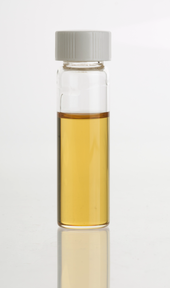
Anise
Other uses
Builders of steam locomotives in Britain incorporated capsules of aniseed oil into white metal plain bearings so the distinctive smell would give warning in case of overheating.[43] Anise can be made into a liquid scent and is used for both drag hunting and fishing. It is put on fishing lures to attract fish.[44][45]
References
- ^ from Franz Eugen Köhlae, Köhlae's Medizinal-Pflanzen, 1897
- ^ a b "Pimpinella anisum L." World Flora Online. World Flora Consortium. 2023. Retrieved 22 January 2023.
- ISBN 978-1-4058-8118-0.
- ^ a b c Baynes 1878.
- ^ "Anice vera, Pimpinella anisum L." Flora Italiana. Altervista. n.d.
- ^ Lewis, Charlton T.; Short, Charles (1879). "ănēthum". A Latin Dictionary. Perseus Digital Library.
- ^ "Anise". Oxford Dictionaries, Oxford University Press. 2018. Archived from the original on March 4, 2018. Retrieved 3 March 2018.
- ^ "s.v. 'anise'".
- ^ a b Stephens, James M. (April 1997). "Anise—Pimpinella anisum L." AskIFAS. University of Florida Institute of Food and Agricultural Sciences. Retrieved 22 January 2023.
- ^ a b Katzer, Gernot (9 September 1998). "Anise (Pimpinella anisum L.)". Spice Pages.
- ^ "Aniseed - Cargo Handbook - the world's largest cargo transport guidelines website". cargohandbook.com. Retrieved 2022-05-25.
- ^ a b Chisholm 1911.
- ^ "Anise Uses, Benefits & Side Effects - Drugs.com Herbal Database". Drugs.com. Retrieved 2022-05-25.
- ^ "Tips for Transplanting Seedlings". Almanac.com. Retrieved 2022-05-25.
- ISBN 978-1-85573-721-1.
- ]
- ^ J.S. Pruthi: Spices and Condiments, New Delhi: National Book Trust (1976), p. 19.
- ^ Branch, Legislative Services. "Consolidated federal laws of canada, Food and Drug Regulations". laws.justice.gc.ca. Retrieved 2018-07-19.
- ^ "Anise seed: Properties, benefits, mischief, dosage, and side effects". Alwosta. Archived from the original on 2020-09-25. Retrieved 2024-02-05.
- ^ "Favourite traditional British sweets: in pictures". www.telegraph.co.uk. Retrieved 2021-05-23.
- ^ a b Peter, K.V. (2012). Handbook of herbs and spices Volume 2. p. 143.
- ^ "Anise History". Our Herb Garden. March 2013. Retrieved 3 March 2013.
- ^ "Wedding Cake: A Slice of History | Carol Wilson". Gastronomica. 2005-05-05. Retrieved 2017-11-13.
- ^ a b c d e f Dealberto, Clara; Desrayaud, Lea (25 July 2017). "Le pastis, elixir provencal". Le Monde. Le Monde. p. 28.
- ^ a b "16 Anise-Flavored Liquors | SenseList". senselist.com. Retrieved 13 November 2017.
- ISBN 978-1-57607-833-4. Retrieved 28 March 2013.
- ^ admin. "Chincon". Chincon (in Spanish). Retrieved 2022-11-06.
- ISBN 9788496054127. Retrieved 5 February 2013.
- ^ "Majorcan herb liqueur in Spain". Spain.info. 2007-04-23. Retrieved 22 January 2018.
- ^ "Xtabentún Cocktail Guide, with Origins and Recipes". Wine Enthusiast Magazine. 29 February 2012. Archived from the original on 27 November 2022. Retrieved 13 November 2017.
- PMID 16042427.
- PMID 15751338.
- ^ "Virgil's Bavarian Nutmeg". Reeds. Archived from the original on April 21, 2014. Retrieved May 12, 2014.
- ^ "Virgil's Rootbeer – Spike's Root Beer Reviews and Ratings". Root Beer Reviews. Retrieved May 12, 2014.
- ^ John Gerard, The Herball, or Generall Historie of Plantes Archived 2011-06-14 at the Wayback Machine, 1597, p. 880, side 903
- OCLC 504358830.
- ^ Baytop, T. (1999) Therapy with medicinal plants in Turkey, Past and Present. Kitapevi, Istanbul, Turkey, 2nd edition, pp. 142.
- ^ doi:10.1002/ffj.1813.
- .
- PMID 12617576.
- ISSN 0926-6690.
- ^ Jodral, Manuel Miro. Illicium, Pimpinella and Foeniculum. CRC Press, 2004. pp. 205
- ^ The Railway Magazine. 99: 287. 1953.
{{cite journal}}: CS1 maint: untitled periodical (link) - ISBN 978-0-415-35224-6.
- ISBN 978-0-85238-280-6.
Further reading
- Baynes, T. S., ed. (1878), , Encyclopædia Britannica, vol. 2 (9th ed.), New York: Charles Scribner's Sons, pp. 57–58
- Chisholm, Hugh, ed. (1911), , Encyclopædia Britannica, vol. 2 (11th ed.), Cambridge University Press, p. 55

